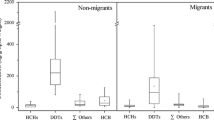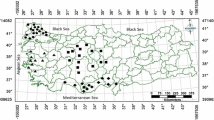Abstract
Levels of organochlorine pesticides (OCPs) and PCB were determined in three duck species: Pintail (Anas acuta), Common Teal (Anas creaca), and Mallard (Anas platyhynchos). Both persistent organochlorines were more abundant in muscle than in the liver; Mallard had the highest levels of PCBs [84.0 ± 39.0 ng/g wet weight (ww)], and Common Teal showed the highest levels of DDTs (561.0 ± 220.0 ng/g ww). This exposure level is more than two orders of magnitude below provisional tolerable daily intake (PTDI) (0.01 mg/kg bw for DDT and its associated compounds) of The Food and Agriculture Organization of the United Nations (FAO) and the World Health Organization (WHO).



Similar content being viewed by others
References
Boumphrey RS, Harrad SJ, Jones KC, Osborn D (1993) Polychlorinated biphenyl congeners patterns in tissues in from a selection of British birds. Environ Contam Toxicol 25:346–352
Bouwman H, Polder A, Venter B, Skaare JU (2008) Organochlorine contaminant in cormorant, darter, egret, and ibis eggs from South Africa. Chemosphere 71:227–241
Braune BM, Mallory ML, Gillchrist HG, Letcher RJ, Drouillard KG (2007) Levels and trends of organochlorines and brominated flame retardants in ivory gull egg from the Canadian Arctic, 1979 to 2004. Sci Total Environ 378:403–417
Choi JW, Matsuda M, Kawano M, Wakimoto W, Iseki N, Masunaga S, Hayama S, Watanuki Y (2001) Chlorinated persistent organic pollutants in black-tailed gulls (Larus crassirostris) from Hokkaido, Japan. Chemosphere 44:1375–1382
Cleemann M, Riget F, Paulsen GB, Dietz R (2000) Organochlorines in Greenland glaucous gulls (Larus hyperboreus) and Icelandic gulls (Larus glaucoides). Sci Total Environ 17(245(1–3)):117–130
Cramp S, Simmons KEL (1997) Handbook of the birds of Europe, the Middle East, and North Africa. Vol 1. Oxford University Press, Oxford, p 722
Dahmardeh Behrooz R, Esmaili-Sari A, Bahramifar N, Ghasempouri M (2009) Organochlorine pesticide and polychlorinated biphenyl residues in human milk from the southern coast of Caspian Sea, Iran. Chemosphere 74:931–937
Das K, Siebert U, Gillet A, Dupont A, Di-Poï C, Fonfara S, Mazzucchelli G, De Pauw E, De Pauw-Gillet MC (2008) Mercury immune toxicity in harbour seals: links to in vitro toxicity. Environ Health 7:52
Drooge BV, Mateo R, Vives I, Cardiel I, Guitart R (2008) Organochlorine residue levels in livers of birds of preys from Spain: inter- species comparison in relation with diet and migratory patterns. Environ Pollut 153:84–91
EU, European Union, 2002 Maximum residue limits for pesticides residues in food commodities http://europe.eu.int/comm/food/fs/ph_ps/pest/index_en.htm
Fang L, Zheng M, Zhang B, Gao L, Liu W, Zhao X (2007) Polychlorinated dibenzo- p-dioxins and dibenzofurans in eggs of eight avian species from Dongting Lake, China. Chemosphere 69:411–421
Fossi MC, Massi A, Lari L, Marsili L, Focardi S, Leonzio C, Renzoni A (1995) Interspecies differences in mixed function oxidase activity in birds: relationship between feeding habits, detoxication activities and organochlorine accumulation. Environ Pollut 90:15–24
Heidari H (2003) Farmer field schools (FFS) slash pesticides use and exposure in Islamic Republic of Iran. Agro-chemicals Report; 1–3
Hobson KA (1993) Trophic relationships among high arctic sea bird: insight from tissue-dependent stable-isotope models. Mar Ecol Prog Ser 95:7–18
Hosseini SV, Behrooz RD, Esmaili-Sari A, Bahramifar N, Hosseini SM, Tahergorabi R, Hosseini SF, Feas X (2008) Contamination by organochlorine compound in the edible tissue of four sturgeon species from the Caspian Sea (Iran). Chemosphere 73:272–279
Jasper VLB, Covaci A, Voorspoels S, Dauwe T, Eens M, Schepens P (2006) Brominated flame retardants and organochlorine pollutants in aquatic and terrestrial predatory birds of Belgium: levels, pattern, tissue distribution and condition factors. Environ Pollut 139:340–352
Jimenez B, Rodriguez-Estrella R, Ruben M, Gomez G, Rivera L, Gonzalez MJ, Abad E, Rivera J (2005) Results and evaluation of the first study of organochlorine contaminants (PCDDs, PCDF, PCBs and DDTs), heavy metals and metalloids in birds from Baja California, Mexico. Environ Pollut 133:139–146
Nakata H, Tanabe S, Tatsukawa R, Koyama Y, Miyazaki N, Belikov S, Boltunov A (1998) Persistent organochlorine contaminants in ringed Seals (Phoca hispida) from the Kara Sea, Russian Arctic. Environ Toxicol Chem 17:1745–1755
Naso B, Perrone D, Ferrante MC, Zaccaroni A, Lucisan A (2003) Persistent organochlorine pollutants in liver of birds of different trophic levels from coast area of Campania, Italy. Arch Environ Contam Toxicol 45:407–414
Olafsdottir K, Petersen AE, Magnusdottir EV, Bjornsson T, Johannesson T (2001) Persistent organochlorine levels in six prey species of the gyrfalcon (Falco rusticolus) in Iceland. Environ Pollut 112:245–251
Prato E, Biandolino F (2007) Combined toxicity of mercury, copper and cadmium on embryogenesis and early larval stages of the Mytilus galloprovincialis. Environ Technol 28:915–920
Rahbar E (2002). Ecological studies and assessment of Siberian White Crane habitat in Fereidoon kenar wetland in Iran. Thesis Submitted for Degree of Master of Science (M.Sc.) Tarbiat Modares University, 108 pp
Steevens JA, Benson WH (2001) Toxicokinetic interactions and survival of Hyalella azteca exposed to binary mixtures of chlorpyrifos, dieldrin, and methyl mercury. Aquat Toxicol 51:377–388
Verslycke T, Vangheluwe M, Heijerick D, De Schamphelaere K, Van Sprang P, Janssen CR (2003) The toxicity of metal mixtures to the estuarine mysid Neomysis integer (Crustacea: Mysidacea) under changing salinity. Aquat Toxicol 64:307–315
WHO/FAO, World Health Organization/Food and Agriculture Organization, 2002
Acknowledgments
We thank Dr. Mozhgan Savabieasfahani for support and guidance in writing this manuscript. We are also grateful to H. khedri, M. Davodi, H. Malvandi and M.Sakizade for scientific assistance. This work was funded by the Tarbiat Modares University of Iran.
Author information
Authors and Affiliations
Corresponding author
Additional information
An erratum to this article can be found at http://dx.doi.org/10.1007/s00128-010-0129-3
Rights and permissions
About this article
Cite this article
Rajaei, F., Bahramifar, N., Sari, A.E. et al. PCBs and Organochlorine Pesticides in Ducks of Fereydoon-kenar Wildlife Refuge in Iran. Bull Environ Contam Toxicol 84, 577–581 (2010). https://doi.org/10.1007/s00128-010-9988-x
Received:
Accepted:
Published:
Issue Date:
DOI: https://doi.org/10.1007/s00128-010-9988-x




